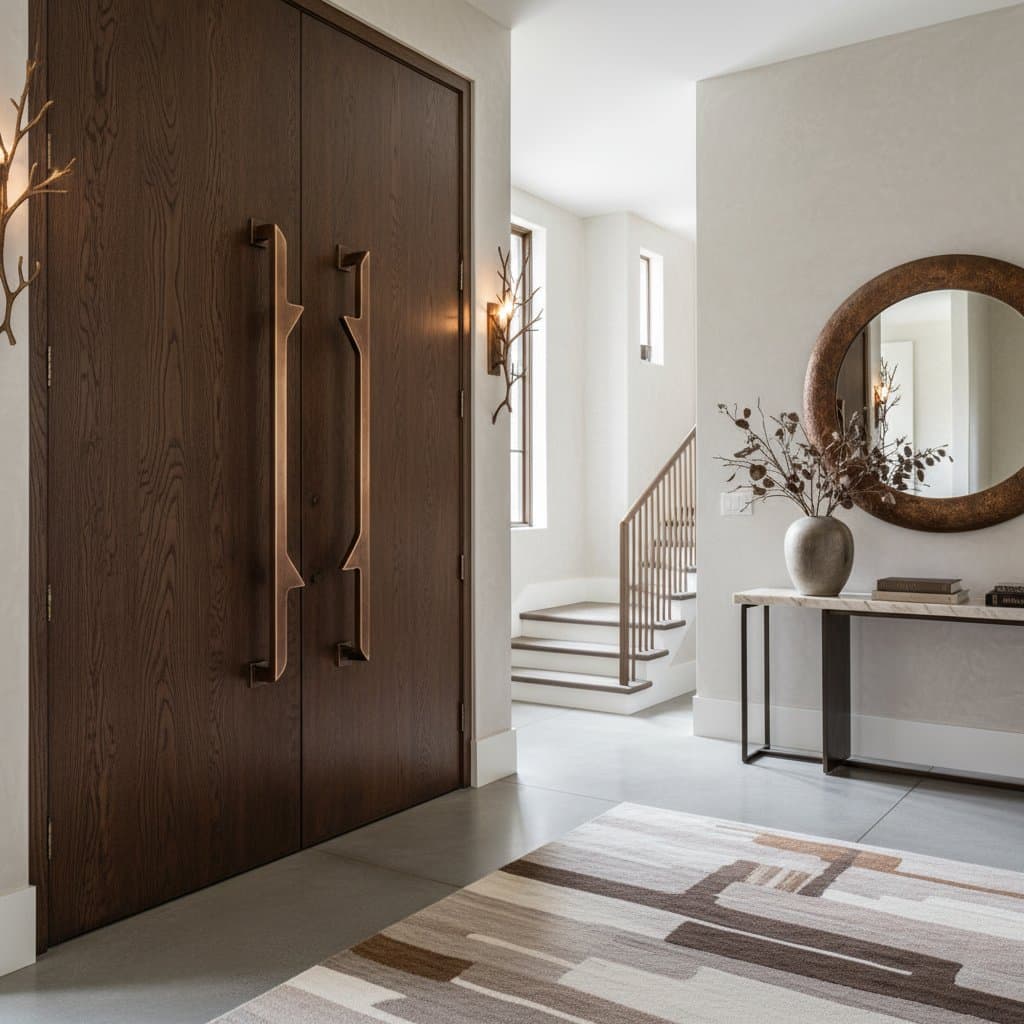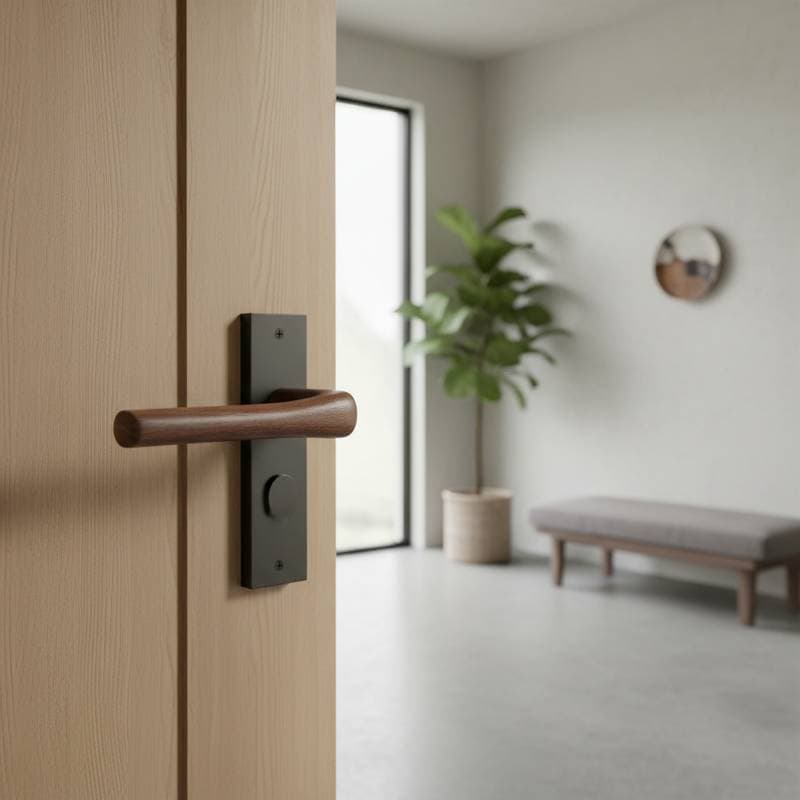The $400M Black Bronze Trend Replacing Matte in 2025
Design professionals observe a gradual shift away from pure matte finishes. Black bronze emerges as the next evolution for exteriors, doors, windows, and hardware. This finish delivers a grounded, timeless, and quietly luxurious appearance. Unlike the flat quality of matte black, black bronze introduces warmth and depth through subtle metallic undertones that vary with natural light.
Black bronze suits both modern and traditional homes. It evokes a handcrafted aesthetic that appears premium without ostentation. The finish merges the boldness of black with the nuance of aged metal. Homeowners value its adaptability and durability, as it conceals fingerprints and weathering more effectively than standard matte surfaces. Black bronze represents more than a color selection; it embodies a material sensibility that conveys refinement and longevity.
Three Ways to Achieve This Look
Budget-Friendly Approach ($3,000 - $6,000)
- Select vinyl or aluminum-clad windows in deep bronze finishes. Manufacturers provide powder-coated options that replicate black bronze at reduced expense.
- Update front entry door hardware and lighting fixtures for immediate curb appeal enhancement.
- Direct funds toward prominent zones such as entryways or garage doors to maximize visual impact.
- Incorporate fiber cement siding in charcoal or dark espresso shades to harmonize with bronze elements while minimizing upkeep.
Mid-Range Approach ($7,000 - $15,000)
- Install fiberglass or steel doors finished in black bronze, accented with satin brass or oil-rubbed bronze hardware for subtle contrast.
- Refresh window trim to align with or complement the door finish. Combine with engineered wood or premium vinyl siding in warm gray or taupe to offset darker tones.
- Integrate bronze-toned exterior lighting and house numbers for a unified color scheme.
- Apply a black-bronze finish to garage doors, incorporating woodgrain texture to establish a compelling focal point.
Premium Approach ($16,000 - $40,000)
- Opt for solid wood doors featuring custom black bronze patina hardware. Species such as walnut, mahogany, or oak, stained in espresso, integrate seamlessly with the metallic elements.
- Fit real metal-clad windows or thermally broken steel frames in dark bronze.
- Employ natural materials like cedar siding, treated with semi-transparent stains that reflect the hardware's undertones.
- Extend black bronze to gutters, railings, and lighting fixtures for a unified architectural expression.
- Utilize marine-grade coatings or high-performance powder coats to ensure resistance to corrosion and UV degradation.
Material and Finish Guide
-
Windows: Slimline black bronze aluminum frames offer a crisp, modern silhouette without the severity of pure black. Traditional homes benefit from divided-light grids in bronze tones for added dimension. Select hardware in antique brass or dark pewter to achieve equilibrium in contrast.
-
Doors: Wood or composite doors coated in black bronze provide warmth and substance. Glass inserts with bronze-tinted or frosted panels ensure privacy. Flat-panel doors with restrained hardware suit contemporary preferences.
-
Siding: Board and batten styles in dark espresso or charcoal form a striking foundation for bronze highlights. Fiber cement or engineered wood withstands coastal or humid environments without color loss.
-
Trim and Accents: Apply black bronze to gutters, window trim, railings, and exterior light fixtures for cohesion. Details such as address numbers and mailbox finishes reinforce the overall design unity.
Maintenance Essentials
Black bronze outperforms matte black in outdoor settings. The faint metallic luster masks dust, fingerprints, and light scratches. Powder-coated or anodized applications clean easily with mild soap and water. Steer clear of abrasive tools or strong chemicals that might diminish the surface sheen.
Wood doors or siding with bronze stains require regular sealing to sustain vibrancy, particularly in high-sun or coastal areas. Metal-clad windows and doors benefit from periodic rinsing to eliminate salt or mineral deposits. Individuals seeking minimal effort should choose composite options or robust coatings that emulate bronze depth without refinishing needs.
Consistent maintenance preserves the finish's allure over time. A seasonal wash and inspection suffice to maintain its depth for years.
Common Pitfalls to Avoid
-
Incompatible Metal Pairings: Bright chrome or polished nickel disrupts black bronze harmony. Adhere to warm metallics such as antique brass, copper, or oil-rubbed bronze.
-
Overlooking Environmental Factors: Matte paints on metal doors may fade or chalk under intense sun. Prioritize UV-stable coatings or factory-applied exterior finishes.
-
Excessive Darkness: Overuse of black or bronze weighs down the facade. Introduce lighter siding or stone elements for necessary contrast.
-
Neglecting Sample Reviews: Examine finish samples under natural light. Black bronze undertones range from cool gray to warm brown based on illumination and adjacent materials.
Coordinating Colors and Styles
Build harmony around black bronze with a palette that amplifies its richness. Effective combinations include:
- Siding: Warm gray, deep taupe, or dark espresso
- Trim: Soft beige or stone gray
- Door: Black bronze or espresso stain
- Hardware: Aged brass or dark bronze
- Accent Color: Olive green, rust red, or navy blue
This scheme adapts to diverse architectures. Modern residences gain from dark bronze against pale stucco or cedar. Traditional structures acquire depth through pairings with cream or brick.
Exterior lighting influences perception. Warm LED fixtures accentuate the bronze warmth, rendering the finish more layered after dark.
Exterior Documentation Checklist
Homeowners should record their current exterior thoroughly before committing to changes. This practice aids in assessing black bronze integration with existing features and surroundings.
Essential Records:
- Photographs of the exterior from various perspectives, featuring detailed shots of doors, windows, and trim.
- Descriptions of architectural style, including historic or ornamental elements requiring preservation.
- Observations of neighborhood aesthetics and any association guidelines on colors or finishes.
- Details on climate and exposure, such as sunlight orientation, wind patterns, or humidity levels impacting material performance.
- Budget outlines and prioritized zones for optimal investment returns.
Organized records facilitate collaboration with contractors and designers. They also avert errors from mismatched or unsuitable selections.
Adapting to Regional Climates
In warm regions, black bronze absorbs less heat than solid black, supporting cooler interiors. Metallic components lower surface temperatures on doors and frames. Colder areas see energy benefits from the dark hue's heat retention.
Coastal zones necessitate corrosion protection. Seek salt-rated finishes for hardware and lights. Powder-coated aluminum or marine-grade stainless steel in bronze endures without repeated treatments.
Humid locales favor mold-resistant sidings like fiber cement or composite wood. Black bronze's subtle sheen conceals minor discoloration superior to flat paints, upholding a polished exterior.
Integrating Black Bronze Effectively
Black bronze signifies a move toward textured, enduring exteriors that blend artistry with subtlety. It fuses precise modernity with vintage appeal, yielding a contemporary yet artisanal result. Homeowners appreciate its flexibility across glass-heavy moderns and wood-clad rustics, providing dimension absent in matte alternatives.
Full overhauls prove unnecessary. Targeted enhancements like hardware swaps, lighting updates, or trim refreshes yield striking results.
The finish's authenticity shines through aging, developing patina rather than wear. Paired with strategic materials and routine care, black bronze transcends trends to deliver enduring elegance.






